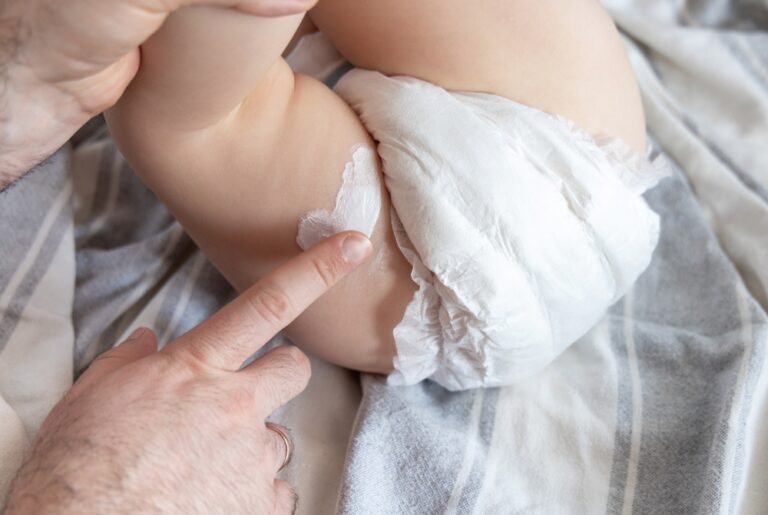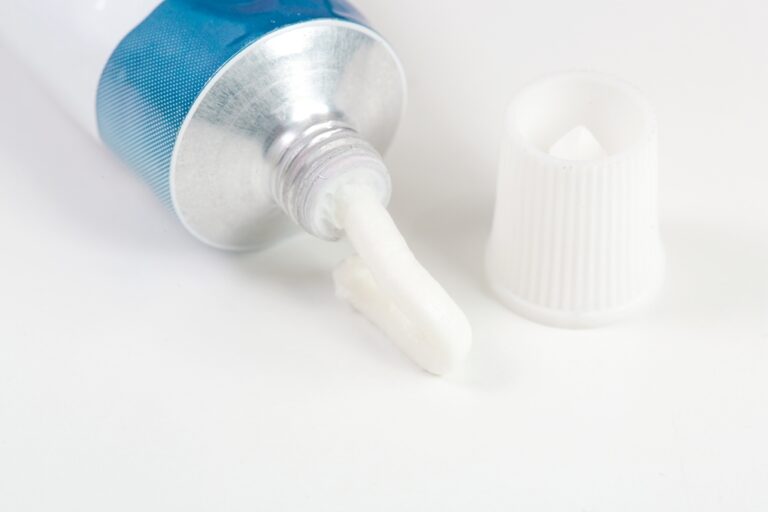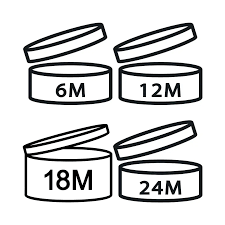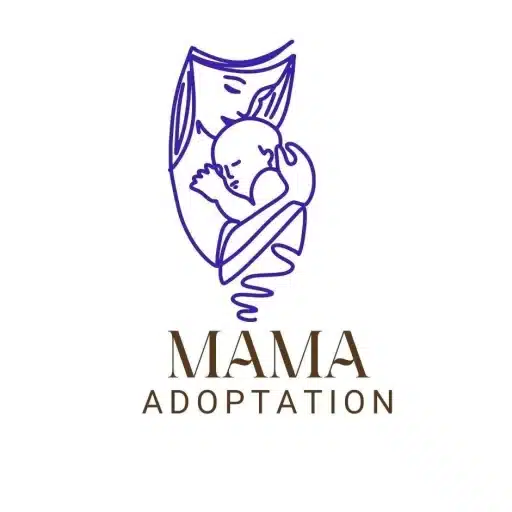Does Diaper Rash Cream Expire?
Diaper rash ointments and creams do expire within three years, but no scientific evidence supports this claim. Manufacturers make the expiration date claims based on their product standards, not on any scientific evidence. Just like any other skincare or medical product, their effectiveness and safety diminish over time.
Most diaper rash creams contain a combination of ingredients designed to form a protective barrier on the skin, prevent irritation, and promote healing. However, the active and inactive ingredients in these creams can break down over time, which means they may not work as effectively once they’ve passed their expiration date.
Most experts suggest that you should use a new tube of cream every six months, regardless of the expiration date. This is because the cream might become ineffective due to changes in ingredients or manufacturing over time.
Is diaper rash cream safe to use?

Many parents are concerned about the safety of cream, as there have been reports of babies getting sick after using it. However, experts say that while there is some risk associated with cream, it is generally safe. In general, the cream should only be used on irritated areas and not on the whole diaper area. It is also essential to remember that even if a cream is safe to use, it may only work for some.
Are there any adverse effects of diaper rash cream used?
Most diaper rash creams are safe when used as directed, but in rare cases, they can cause mild side effects like skin irritation, redness, or allergic reactions, especially if your baby has sensitive skin or the product contains fragrances or preservatives.
Why Do Diaper Rash Creams Expire?
Diaper rash creams generally have a shelf life of about 1 to 3 years from the manufacturing date, depending on the product and packaging. Over time, exposure to air, light, and temperature fluctuations can alter the chemical structure of the ingredients. And if the product is stored improperly or contaminated (like if you dip dirty hands into a jar), the preservatives that keep harmful bacteria at bay can lose their effectiveness, leading to potential microbial growth.
Even if a diaper rash cream doesn’t show visible signs of separation or discoloration, its active ingredients may have degraded, making it ineffective or even risky to use on a baby’s delicate skin.
Shelf Life of Popular Diaper Rash Creams
To help you better understand the shelf life of diaper rash creams, here’s a table outlining the shelf life of some well-known brands. Remember, this is just a general guide, and it’s essential to always check the product label for more specific information.
|
Brand |
Shelf Life |
Expiration Note |
|---|---|---|
|
Triple Paste Medicated Diaper Rash Cream |
3-4 years |
Known for its thick, zinc oxide-based formula, Triple Paste has an extended shelf life. |
|
Desitin |
3 years |
Typically has a 3-year shelf life if unopened. Opened tubes may last around 1-2 years. |
|
Aquaphor |
3 years |
Unopened Aquaphor is usually good for 3 years; opened products should be used within 12-18 months. |
|
A&D Ointment |
2-3 years |
A&D ointment generally lasts for up to 3 years unopened and should be used within 1-2 years after opening. |
|
Johnson’s Baby Diaper Rash Cream |
3 years |
It uses a combination of zinc oxide and petrolatum, which are both stable ingredients that contribute to a longer shelf life. |
|
Burt’s Bees Baby |
2 years |
Since it contains natural ingredients, it tends to have a slightly shorter shelf life. |
|
California Baby |
2-3 years |
These products also have an average shelf life of 2-3 years. |
|
Zinc Oxide Creams |
3 years |
Most zinc oxide-based creams (common in diaper rash products) expire within 3 years. |
What Makes Diaper Rash Cream Expire Faster?
Several factors can accelerate the expiration process of diaper rash cream. Here are some of the key reasons why a cream may lose its effectiveness more quickly:

- Storing creams in open jars or tubes can lead to degradation of active ingredients, reducing effectiveness.
- High heat or extreme cold can alter the cream’s texture and chemical composition. Storing creams in warm, humid places like bathrooms can accelerate ingredient breakdown.
- Using dirty hands or sharing creams between children can introduce bacteria or fungi, significantly shortening the product’s shelf life.
- Creams with natural oils or extracts (e.g., lavender, tea tree oil, coconut oil, or aloe vera) may expire faster than those with synthetic ingredients due to their susceptibility to oxidation.
- Frequent Opening of the Container
- Jars are more prone to contamination and air exposure compared to airtight tubes or pump bottles, which can hasten expiration.
- Interactions with other products (like baby oils, lotions, or wipes) can affect the cream’s ingredients.
- Trial-sized or sample versions of diaper rash creams often have shorter shelf lives and may have been stored for extended periods before distribution.
How to Tell If Diaper Rash Cream Has Expired
When it comes to how to tell if diaper rash cream has expired, there are a few simple checks you can do at home.
- Printed Expiry vs “Period After Opening” (PAO)
Many brands now include a small jar icon with “6M,” “12M,” or “24M” that tells you how many months the formula remains effective after first opening. Even if the calendar date is months away, count from when you peeled off that seal.

- Deciphering the Batch Code
Some manufacturers don’t print a clear MM/YYYY date but encode manufacturing dates in a batch code. Visit the brand’s website or contact customer service to decode it, this can reveal exactly when the zinc oxide and preservative blend was produced. - Inspect for Color Changes
A yellow tint in zinc oxide formulas or unexpected darkening in botanical blends can signal ingredient breakdown. - Sniff for Off-Odors
Any sour, rancid, or musty smell means the preservative system may have failed and bacteria could be growing. - Examine Texture and Consistency
Phase separation (watery layer), graininess, or clumping indicates the emulsion and thickening agents have degraded. - Perform a 24-Hour Patch Test
Apply a small dab to your inner wrist. Redness, itching, or dryness within a day means it’s time to toss the tube. - Review Storage Conditions
Ensure it’s kept in a cool, dry cabinet, not near radiators, hot cars, or steamy bathrooms, to preserve potency. - Consider Potency Loss Over Time
Remember that zinc oxide barrier efficacy can drop by up to 25 percent after 18 months, even if the cream “looks” fine.
Can You Use Expired Diaper Rash Cream?
Using expired diaper rash cream poses several risks beyond reduced effectiveness. Over time, preservatives can degrade, leading to microbial growth; a study found that 15% of expired cosmetic tubes contained harmful bacterial levels. Additionally, the cream’s physical and chemical properties change, with zinc oxide particles aggregating and reducing barrier efficacy by nearly 25% after 18 months, making skin more susceptible to moisture and irritation. The breakdown of emulsifiers can also alter the cream’s pH, potentially irritating inflamed skin and compromising its antimicrobial properties.
Given these risks of microbial contamination, diminished barrier protection, and pH imbalance, it’s advisable to avoid using diaper rash creams past their expiration date. In emergencies, if you must use expired cream, apply it only to intact skin for a short time and monitor for irritation. Alternatives like coconut oil or Vaseline are recommended if available.
Alternatives to Expired Diaper Rash Cream
There are several non-toxic diaper rash cream alternatives available when store-bought options are not accessible. These can be made easily at home using pantry staples.
- Use pure petroleum jelly. It forms a moisture-barrier film with just one ingredient; apply a thin layer to protect skin.
- Mix 1 tbsp coconut oil with ½ tsp arrowroot (or cornstarch) for gentle moisture control and soothing.
- Melt 1 tbsp shea butter, stir in 1 tsp calendula-infused oil, and let cool. It is rich in fatty acids and anti-inflammatory terpenes.
- Combine 1 tbsp melted beeswax with 2 tbsp olive or sunflower oil; pour into a tin and let set for a semi-solid barrier balm.
- To make a calming, anti-itch paste, mix 1 tablespoon colloidal oatmeal with 2 tablespoons water (or breast milk); rinse off after a few minutes.
- Mix 1 tsp each of manuka honey and olive oil; the honey’s non-peroxide antimicrobial properties assist in maintaining clear and rash free skin.
FAQ’s
1. Does diaper rash cream lose effectiveness over time?
Yes. As emulsifiers degrade and zinc oxide particles aggregate, the cream’s barrier-forming film becomes patchy and less occlusive, dropping moisture-lock efficacy by up to 25 percent after 18 months, even if it looks unchanged.
2. Can you use diaper rash cream on a baby’s face?
No, most diaper creams are ultra-occlusive and formulated with high zinc oxide levels and emollients that can clog facial pores and irritate delicate eyelid skin. If you must, choose a non-comedogenic, fragrance-free formula and apply sparingly only to intact skin, avoiding the eye area.
3. Can diaper rash cream help a yeast infection?
No, zinc oxide in diaper cream can slow yeast growth a little but won’t cure it. For a true yeast infection, use a doctor-recommended antifungal cream (like nystatin or clotrimazole), and then you can apply a thin layer of diaper cream around the treated area to protect the skin.
4. Can diaper rash cream help eczema?
While zinc oxide creams form a protective moisture barrier that can soothe and shield eczematous skin, they don’t address the underlying immune-driven inflammation or dryness. For true eczema flare-ups, use a dermatologist-recommended emollient or mild topical steroid first, and then you can layer on a thin film of diaper rash cream to lock in hydration.








